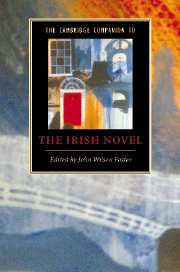Book contents
- Frontmatter
- Introduction
- 1 The novel before 1800
- 2 The national tale and allied genres, 1770s-1840s
- 3 The novel of the big house
- 4 The Gothic novel
- 5 Catholics and fiction during the Union, 1801-1922
- 6 Irish modernisms, 1880-1930
- 7 James Joyce
- 8 Region, realism and reaction, 1922-1972
- 9 The novel in Irish
- 10 Women novelists, 1930s-1960s
- 11 Two post-modern novelists: Samuel Beckett and Flann O’Brien
- 12 Life writing in the twentieth century
- 13 The novel and the Northern Troubles
- 14 Contemporary Irish fiction
- Index
4 - The Gothic novel
Published online by Cambridge University Press: 28 January 2007
- Frontmatter
- Introduction
- 1 The novel before 1800
- 2 The national tale and allied genres, 1770s-1840s
- 3 The novel of the big house
- 4 The Gothic novel
- 5 Catholics and fiction during the Union, 1801-1922
- 6 Irish modernisms, 1880-1930
- 7 James Joyce
- 8 Region, realism and reaction, 1922-1972
- 9 The novel in Irish
- 10 Women novelists, 1930s-1960s
- 11 Two post-modern novelists: Samuel Beckett and Flann O’Brien
- 12 Life writing in the twentieth century
- 13 The novel and the Northern Troubles
- 14 Contemporary Irish fiction
- Index
Summary
Origins of the Gothic novel
[W]hatever is fitted in any sort to excite the ideas of pain and danger, that is to say, whatever is in any sort terrible, or conversant with terrible objects, or operates in a manner analogous to terror, is a source of the sublime.
It is something for a man to be able to walk from his own door to his place of worship without being shot at from behind his father’s tombstone.
After 1757, a large number of novels in English adopted, explored, adapted and perverted the aesthetic theories set out in Edmund Burke's A Philosophical Enquiry into the Origin of our Ideas of the Sublime and Beautiful. They did this through new attention to landscape, through the deployment of historical settings and themes, and through an interest in the sensational and the supernatural. The most obvious influence of Burke's treatise is found in the subgenre of terror fiction that quickly identified itself as Gothic.
The sublime is produced by great and terrible objects, including natural phenomena like oceans, mountains and waterfalls, as well as great buildings whose size overwhelms the spectator. Burke emphasises that a certain amount of obscurity is necessary for the creation of terrible effects. To enter a ruined abbey on a moonlit night would be to invite the experience of the sublime. Small and pleasing objects are beautiful, and, in terms of landscape, the beautiful is associated with domesticity and cultivation. Burke leads his readers to associate the sublime with masculinity and the beautiful with femininity.
- Type
- Chapter
- Information
- The Cambridge Companion to the Irish Novel , pp. 78 - 96Publisher: Cambridge University PressPrint publication year: 2006
- 4
- Cited by



